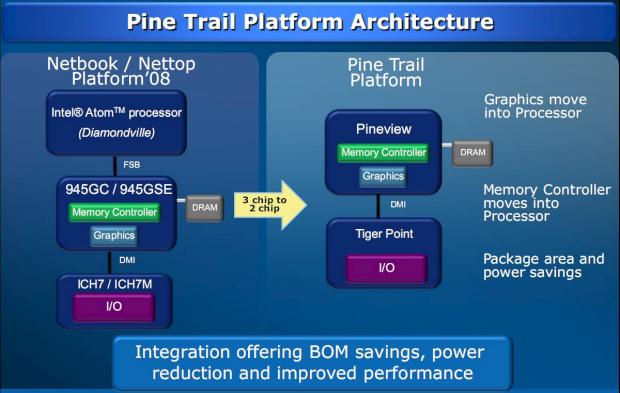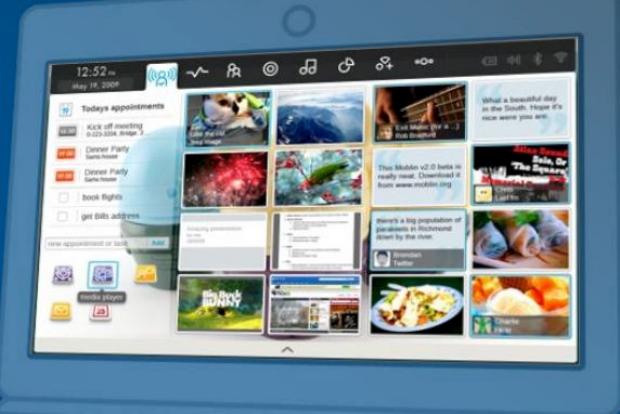Intel just held a teleconference outlining some information on its next Atom platform, code-named “Pine Trail” and introduced a new beta version of its “Moblin” user interface for upcoming Atom-based netbooks, nettops, MIDs, embedded systems, and in-vehicle entertainment systems. Here are some notes from the call…
Intel’s next-generation Atom platform, code-named Pine Trail
From an architecture standpoint, there will be a shift to a 2-chip architecture which will enable four-layer PCB routing. This is versus the current 3-chip setup consisting of the CPU, chipset (graphics, RAM, etc.), and the I/O.
With Pine Trail, the CPU, graphics, and memory controller will now all be in the “north” complex, while I/O will be in the “south” complex. This new configuration allows for a move from a six-layer board to a four-layer board. That means slimmer designs, fanless (in nettops), lower costs, better battery, better performance, etc.

Reduced Power
- Energy-efficient Intel Atom microarchitecture
- Lower TDP – thinner form factors, fanless potential
- Average power reduction = improved battery life
Improved Performance
- Higher processor performance
- Increased graphics performance
- Memory controller integrated with processor
Update on Moblin
Optimized for Intel Atom processor-based devices, Moblin is an open-source Linux operating system featuring the following:
- Fast boot — dramatically reduced boot times. Alpha versions saw boot times as fast as five seconds. Finished version will be closer to ten seconds.
- Small Footprint — strip out unneeded fluff for low-memory devices.
- Battery life optimization
Mobile v2.0 Beta User Experience — now available at MoblinZone.com

- M-zone (My Zone) replaces the desktop; it’s the entry point to the netbook and nettop. Designed to get you to 90% of what you want to access within one click. Calendar/task/appointments, frequently used applications, recent documents and files, status and updates from social networks.
- Easy and personalized social networking — interaction via various APIs, don’t need to go to full web pages.
- Simplified internet and rich media consumption — Mozilla-based browser optimized for screen size, power, and performance. Media player features searching, finds all your files, etc.
- Customizable for OEMs and Service Providers
- Open source, designed from the ground-up.
- 15 Linux OSVs (open source vendors) already on board designing Moblin products.
The main goal of Moblin is to unify a Linux-based OS across Atom-based platforms. There are thousands of applications that will “just run” without porting and hundreds of apps optimized just for Moblin.
Questions
Q: Which OEMs are you working with on Moblin?
A: Can’t comment on future product offerings. Future plans may be announced at Computex by individual vendors.
Q: When will Pine Trail debut? Details on specs, clock speed, etc?
A: Shipping in Q4 from Intel, OEMs will introduce products on their own. No details on specs at this time.
Q: Why does Intel feel the need to push its own operating system?
A: We’ve been involved in open source for a while. These new category devices comprise a lot of different form factors and Moblin is an attempt to unify the Linux experience across all these devices while optimizing battery life, power, etc.
Q: Why would a customer favor Moblin over Microsoft and how might this affect your relationship with Microsoft? What about Ubuntu?
A: Moblin is not designed to be compared to Microsoft. A lot of our OEM vendors have requested both environments. It’s ultimately a platform of choice issue for OEMs. Ubuntu is aligned with the Moblin roadmap.
Q: How do you see the market segmenting between Windows and Moblin?
A: It’s about 20 to 25 percent Moblin right now and it’ll likely continue that way. Really depends on the usage experience that the OEM is trying to put into the market. Windows 7 will also be a good option.
Q: Does the graphics memory move onto the chip with Pine Trail?
A: Yes, it’s a monolithic die.
Q: Why optimize certain Linux apps if they supposedly “just run”?
A: Mostly due to screen size in lower-resolution devices — making sure all the buttons fit on the screen, etc. Many applications don’t need optimization, though. Mostly a UI choice. Some power consumption improvements.
Q: What about graphics — any specifics? Does NVIDIA bring anything to the netbook experience?
A: No graphics specifics right now, but more information will be presented at Computex. NVIDIA (Ion) will not be present within the Pine Trail platform, although OEMs are using Ion on their own.
Q: Will the Moblin V2 UI be available for current Menlow CPUs used in already-available mobile internet devices?
A: No plan for Moblin V2 in current Menlow devices, just future devices.